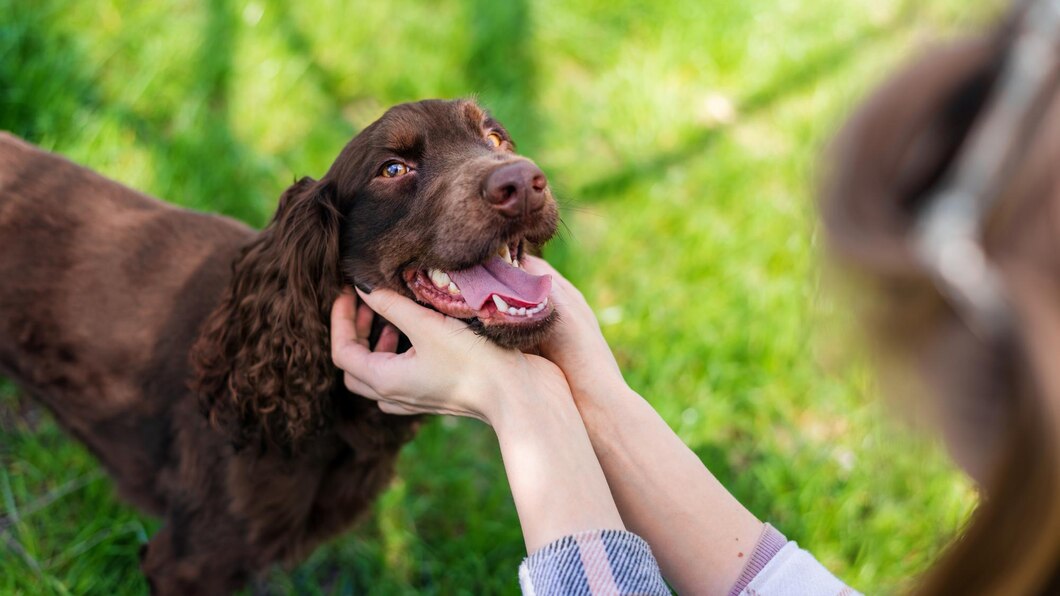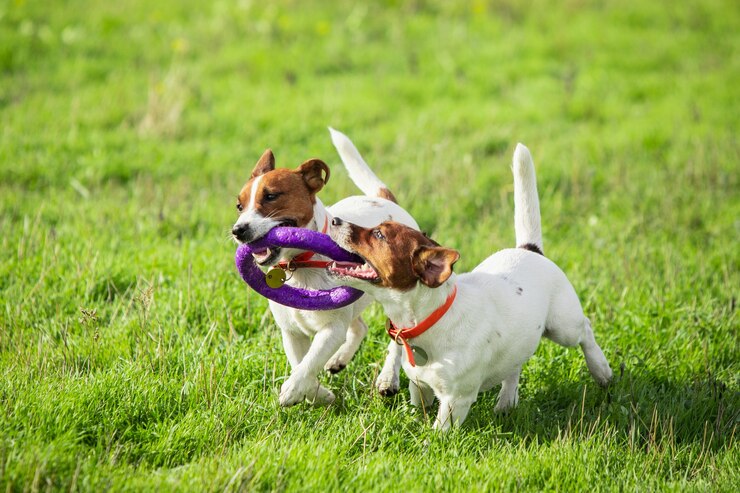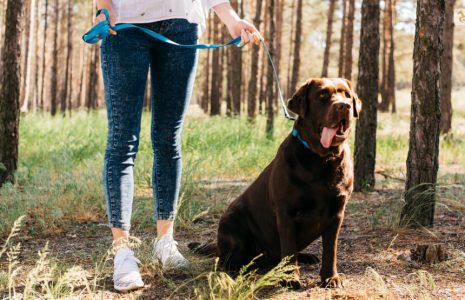Understanding What A Dog’s Body Language Means


Building a strong and communicative relationship with your canine companion is essential for a harmonious life together. One key aspect of this connection is interpreting your dog’s body language. Dogs communicate primarily through non-verbal cues, and deciphering these signals can help you better understand their emotions and needs.
Key Components Of Dog Body Language
Facial Expressions

The face is a window into a dog’s emotions. By paying attention to their facial expressions, you can gain valuable insights into their state of mind.
- Eyes: Dogs convey a lot through their eyes. Wide-open eyes may indicate excitement or curiosity while squinting can signal relaxation. Pay attention to whether your dog is staring directly at you, which can be a sign of attention, or if they are averting their gaze, which may suggest submission or discomfort.
- Ears: The position of a dog’s ears is another important indicator. Forward-pointing ears often signal attentiveness or excitement, while ears laid back against the head might indicate fear or submission.
- Mouth: A dog’s mouth can reveal much about their mood. Relaxed lips and a slightly open jaw usually indicate a calm and content state. On the other hand, bared teeth may signal aggression or discomfort and could precede a dog bite.
Tail Movements
The tail is a dog’s emotional barometer, reflecting their feelings and intentions.
- Wagging: Wagging is not always a sign of happiness. The type of wag, the speed, and the height of the tail all convey different meanings. A slow, low wag might indicate uncertainty or submission, while a high, fast wag suggests excitement or joy.
- Tucked Tail vs. Raised Tail: A tucked tail indicates fear or submission, while a raised tail can signal alertness or confidence. Understanding the context and accompanying body language is crucial for accurate interpretation.
- Stiffness vs. Flexibility: A stiff tail may indicate tension or aggression, while a flexible, relaxed tail usually signals a content or friendly demeanor.
Posture And Body Position
The way a dog holds its body provides additional clues to its emotional state.
- Standing Tall vs. Crouching: A dog standing tall and straight may be expressing confidence or dominance, while a crouching posture might indicate fear or submissiveness.
- Weight Distribution on Paws: If a dog shifts its weight forward, it may be preparing to move or showing interest. Conversely, leaning backward might signify hesitation or fear.
- Arched Back vs. Straight Back: An arched back can be a sign of fear or aggression, whereas a straight back often indicates a calm or neutral state.
Common Dog Body Language Signals
Signs Of Happiness

Understanding when your dog is happy is crucial for providing a positive and enriching environment.
- Relaxed Body: A happy dog will have a loose and relaxed body. Their movements will be fluid and easy-going.
- Playful Behavior: Playfulness is a clear indicator of joy. Dogs often exhibit zoomies, playful barking, and a wagging tail during moments of happiness.
- Loose, Wagging Tail: A wagging and loose tail, especially when accompanied by a calm, composed body, is a classic sign of a happy and satisfied dog.
Signs Of Fear Or Anxiety
Recognizing signs of fear or anxiety is crucial for addressing your dog’s needs and ensuring their well-being.
- Trembling or Shaking: Dogs may tremble or shake when they are afraid, stressed, or anxious. Identifying the trigger can help alleviate their discomfort.
- Cowering or Hiding: A dog that cowers, hides, or seeks shelter may be indicating fear or a sense of vulnerability.
- Whining or Excessive Panting: Whining and excessive panting can be signs of stress. Identifying the cause and providing reassurance can help ease their anxiety.
Signs Of Aggression
Recognizing the signs of aggression is crucial for preventing conflicts and ensuring a safe environment.
- Raised Hackles: Raised hackles along the dog’s back indicate heightened arousal or potential aggression. It’s essential to assess the situation and respond appropriately.
- Growling or Snarling: Audible warnings like growling or snarling signal discomfort or a perceived threat. Understanding the context is vital for addressing the issue.
- Stiff Body Posture: A stiff and rigid body posture is a clear sign of tension or aggression. Avoid provoking the dog and take steps to de-escalate the situation.
Context Matters
Considering The Environment
The context in which a dog expresses its body language is crucial for accurate interpretation.
- Interaction with Other Dogs: Dogs communicate with each other using body language. Understanding how your dog interacts with others can provide valuable insights into their social dynamics.
- Presence of Strangers or New Stimuli: Dogs may exhibit different behaviors in the presence of strangers or unfamiliar stimuli. Observing their reactions can help you gauge their comfort level and respond appropriately.
Individual Differences In Dog Personalities

Recognizing that each dog is unique and may have different temperament traits is key to understanding their behavior.
- Breed-Specific Traits: Different dog breeds may exhibit specific behavioral traits. Understanding these breed-specific characteristics can help you interpret their body language more accurately.
- Previous Experiences and Socialization: A dog’s past experiences and socialization play a significant role in shaping their behavior. Traumatic experiences may influence their reactions in certain situations.
How To Respond Appropriately
Positive Reinforcement
Positive reinforcement is an effective way to extract good behaviors and strengthen the bond between your dog and you.
- Rewarding Desired Behaviors: Reinforce positive behaviors with treats, praise, or affection. This encourages your dog to repeat those behaviors in the future.
- Building Trust Through Consistent Positive Interactions: Consistent positive interactions create a trusting relationship. Spend quality time with your dog, engage in activities they enjoy, and provide a secure and loving environment.
Recognizing And Addressing Signs Of Stress
Identifying signs of stress and addressing them promptly is crucial for your dog’s mental and emotional well-being.
- Offering a Safe Space: Create a designated safe space where your dog can retreat when feeling highly overwhelmed. This could be a comfortable crate or a quiet corner in your home.
- Seeking Professional Help if Needed: If your dog consistently exhibits signs of stress, fear, or aggression, seeking the assistance of a professional dog trainer or behaviorist is advisable. They can provide personalized guidance and support.
Understanding your dog’s body language is a fundamental aspect of responsible pet ownership. By decoding their facial expressions, tail movements, and posture, you can establish a deeper connection and respond appropriately to their needs. Remember that each dog is unique, and context plays a crucial role in interpretation.
Building a positive and communicative relationship with your dog not only enhances their well-being but also fosters a stronger and more fulfilling bond between you and
More From The Petsmagazine:









Leave A Comment